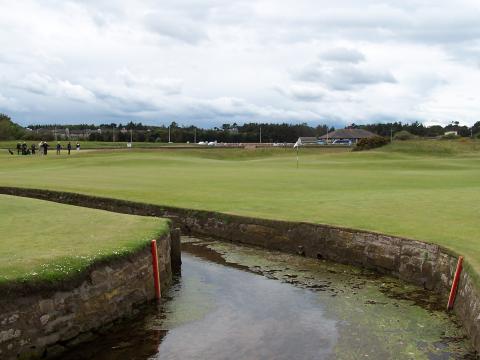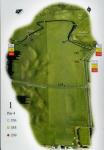
The 11th green at Crail Balcomie Links is shared with the 8th green (background). At any one time, eight players plus caddies share the large expanse.
Yesterday, I wrote about the Old Course at St. Andrews, a dream come true for me after 50 years of golf. Nevertheless, it was an expensive dream; the round cost my son and me about $700 US because of a brutal exchange rate between pound and dollar. The dollar/British pound exchange rate is more favorable now by almost 50%, making a golfing trip to Scotland somewhere between fairly expensive and outrageous. If a trip to the Old Sod is on your wish list, I offer a few tips to ease the burden somewhat.
Mid-June was perfect from a weather and traffic standpoint, so if you have the flexibility to schedule a trip then, consider it. Although you won't get much of a price break compared with the high summer season, your odds of avoiding persistent bad weather are better than earlier in the year. (Note: The driest areas of Scotland suffer 150 days with rain annually, the wettest 250, so bring raingear no matter when you visit.) In seven days of golf, we were rained on only for about six holes on two different golf courses. It went from spring to winter to spring in the course of three holes at the Old Course. Overall, we were exceedingly lucky.
odds of avoiding persistent bad weather are better than earlier in the year. (Note: The driest areas of Scotland suffer 150 days with rain annually, the wettest 250, so bring raingear no matter when you visit.) In seven days of golf, we were rained on only for about six holes on two different golf courses. It went from spring to winter to spring in the course of three holes at the Old Course. Overall, we were exceedingly lucky.
In July, the crowds begin to increase, limiting your chances for having your name pulled out of the ballot box at the Old Course. You can sign up for a stay-and-play package and have your tee times prearranged, but that costs more and will box you into staying at one of the more expensive hotels. The other thing -- and some chauvinists might object to me saying this -- is that in the high season for tourists, you have the greatest chance of hearing a substantial amount of American English spoken on the city streets, around the practice greens and in the local pubs. That may be either comforting or off-putting when visiting another country, depending on your point of view.
Rather than pay the high cost of the more upscale hotels, you might consider a stay at one of the smaller bed and breakfast inns within a half hour of St. Andrews. We stayed in the charming fishing village of Crail, just nine miles from the Old Course and featuring two outstanding links courses in town. I thought Crail Balcomie Links, the 13th-oldest course in the world, was almost the equal of the Old Course experience, and for a lot less in green fees. We stayed in a private house courtesy of a home exchange -- click here for more information and see below -- but I just checked prices for June at the Caiplie House , a bed and breakfast inn in Crail, and a double room is running about $550 US for a week's lodging. There are other choices as well in Crail and the nearby towns. Crail itself doesn't offer much in the way of dining options, but St. Andrews to the north does, and some of the towns south of Crail, such as Anstruther, have a fair complement of restaurants. Crail is surrounded by great golf, including Kingsbarns and the new Castle Course in St. Andrews, and some excellent courses, like Lundin, Elie and Leven Links to the south. None of these is more than a half-hour away.
nine miles from the Old Course and featuring two outstanding links courses in town. I thought Crail Balcomie Links, the 13th-oldest course in the world, was almost the equal of the Old Course experience, and for a lot less in green fees. We stayed in a private house courtesy of a home exchange -- click here for more information and see below -- but I just checked prices for June at the Caiplie House , a bed and breakfast inn in Crail, and a double room is running about $550 US for a week's lodging. There are other choices as well in Crail and the nearby towns. Crail itself doesn't offer much in the way of dining options, but St. Andrews to the north does, and some of the towns south of Crail, such as Anstruther, have a fair complement of restaurants. Crail is surrounded by great golf, including Kingsbarns and the new Castle Course in St. Andrews, and some excellent courses, like Lundin, Elie and Leven Links to the south. None of these is more than a half-hour away.
If you like the dollar exchange rate today and can commit to your Scottish golf vacation, consider booking your tee times and accommodations and paying as soon as possible. You run the mild risk that the dollar will become more favorable in the exchange rate game, but the greater risk is that it will go so far the other way as to make you think twice about going. At least you will know in advance how much you will be paying and can budget for it and then dine appropriately -- in better restaurants if a favorable exchange rate, or maybe ratchet back your dining excursions a little if the dollar nosedives again. The abovementioned Caiplie House offers meals beginning around $18 US, not a bad price in our experience. Truth be told, the food in St. Andrews and the surrounding areas was generally no better than okay. The beer, of course, is great.
Finally, if you want to avoid lodging charges altogether, and you own a home you think someone from Scotland might want to stay in, you can consider signing up for an international home exchange program. Don't dismiss the desirabilty of your home; I heard from a couple in Edinburgh recently that they have exchanged with people in suburban Connecticut, and had a great time.
might want to stay in, you can consider signing up for an international home exchange program. Don't dismiss the desirabilty of your home; I heard from a couple in Edinburgh recently that they have exchanged with people in suburban Connecticut, and had a great time.
There are a few such exchange programs, including HomeLink International, which we use. We had a tremendous initial experience with our swap with George and Dorothy Horsfield of Glasgow. They stayed at our place in South Carolina last April, and we stayed at their cottage in Crail in June. Any anxieties we might have had about our first such exchange melted after a few email exchanges between George and me. We even were able to play a couple of rounds of golf with them at Crail and Scotscraig, the 7th oldest course in the world. Best of all, we have made friends for life.
If you have any questions about our golf vacation or the home swapping program, please contact me.

The fishing village of Crail is picture-postcard perfect, and with reasonably priced lodging and two splendid golf courses in town, it is a great alternative to the higher priced accommodations in St. Andrews.



























